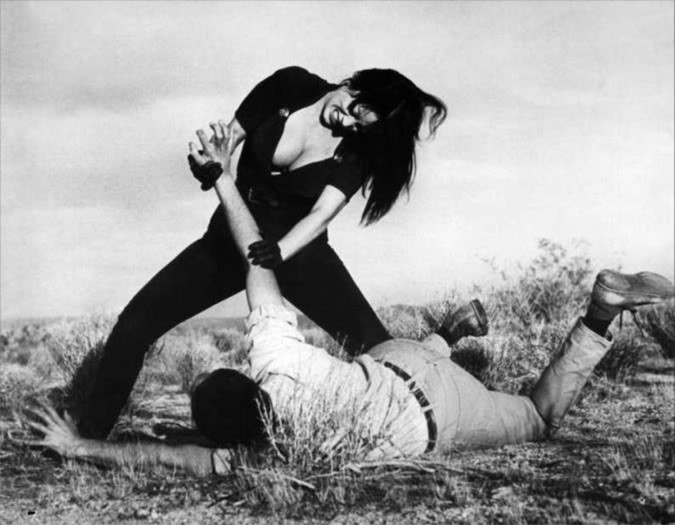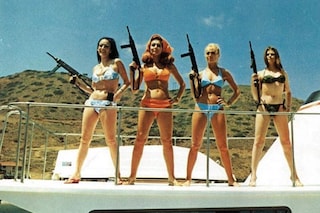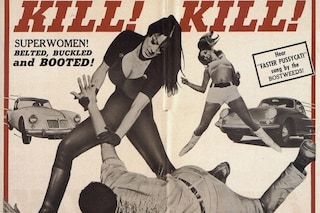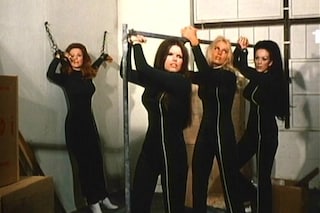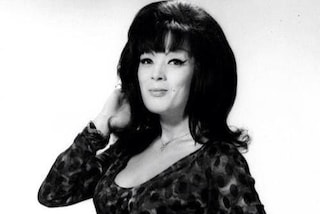On the 50th anniversary of cult hit Faster, Pussycat! Kill! Kill!, we explore the vampish style of its ball-busting gang leader
“Ladies and gentleman, welcome to violence.” Buckled, belted and booted, Tura Satana was the burlesque dancer-turned-action heroine who broke the hearts and bones of all the men who crossed her. The late icon is best known for her role as killer go-go dancer Varla in Russ Meyer’s cult film Faster, Pussycat! Kill! Kill! (1965), during the course of which she drag races across the desert, unleashes some of the cattiest one-liners to have hit celluloid – most of them improvised – and generally kicks patriarchal ass. But her life was stranger than fiction, having lived through the plots of several blockbuster movies before her 16th birthday. Born in Hokkaido, Japan, she spent time in a Japanese relocation camp in California during WWII with her family. She was later gang-raped as a child in Chicago, only for a judge to be paid off by corrupt cops and the young Satana to be punished in a reform school instead. Her response was to fight back twice as hard, forming a tough girl gang to prevent the same thing happening to anyone else in the neighbourhood (she learnt her signature martial arts moves in the process).
From burlesque circuit to B-Movie iconhood, Satana always beckoned you closer with one hand only to chop you down with the other. Her unique style single-handedly broke the cookie-cutter mould of 60s femininity – as Billie puts it in Faster Pussycat, she’s cute, like a “velvet glove cast in iron”. On the 50th anniversary of that film’s release, we take a look back at the original anti-heroine whose style you can later trace in the movies of John Waters, Quentin Tarantino, and the arthouse revenge flicks of Rihanna (naturally).
SHE SLYLY SUBVERTED 60s STYLE CODES

Spending half her career pleasing men – as Miss Japan Beautiful on the burlesque circuit – and the other half cutting them down, Satana’s role as a fantasy femme subverted the girlish tropes of sixties style. Combining strength with sexiness in her appearance, Satana’s eyeliner and eyebrows were as sharp as her on-screen dialogue, and her beehive was piled higher than anyone else’s – see 1968’s Astro Zombies for an ultimate example of sexed-up 60s tropes. Her first proper movie role – as an unrepentant Parisian prostitute, Suzette Wong, in Irma la Douce (1963) – might have been small, but it showed her ability to channel her powerful sensuality to the silver screen. The best example of her contrast with the usual rules of attraction in that era is in Faster, Pussycat – she is starkly different to the other female characters in that film, like the bikini-clad teenybopper the gang end up kidnapping, and even her fellow accomplice Billie. Billie (Lorrie Williams) with her platinum blonde locks, hot-pants and constant grin is the polar opposite to Satana’s skin-tight all-black outfit, blunt bangs and strong resting bitch face.
SHE BROKE THROUGH ASIAN STEREOTYPES ON SCREEN

Born in Japan but with a background that included Japanese, Filipino, Cheyenne Indian and even Scottish heritage, Satana’s beauty was a unique prospect on film – as Satana bluntly puts it in Pamela Des Barres' book Let’s Spend the Night Together (2007), “Orientals weren’t supposed to be busty like I was.” But she was never one to adhere to eastern stereotypes in her performances, either – even her burlesque act, while conjuring geisha-girl fantasies for the audience, incorporated amazing theatrical costumes and authentic martial arts moves. As the fearsome protagonist of Faster, Pussycat, she smashed through the Hollywood stereotype of Asian women being sexually available and submissive – crushing dull all-American boys under her knee-high boots.
HER GIRL GANGS WERE THE ULTIMATE IN SQUAD GOALS
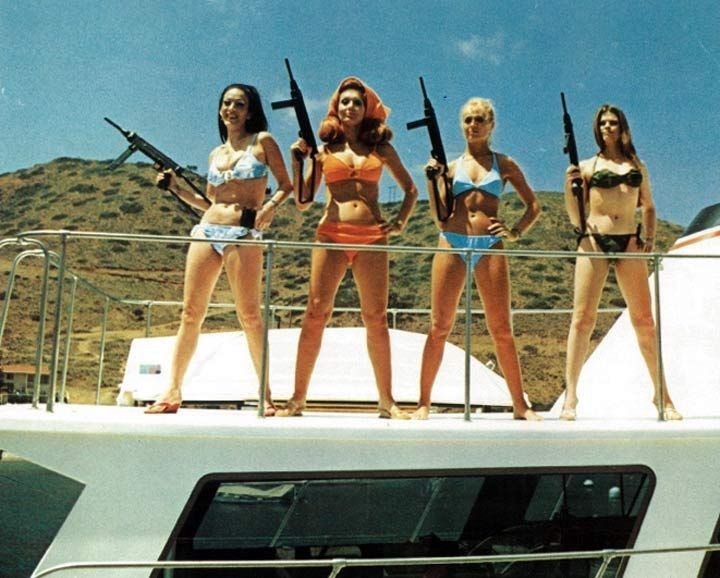
Satana rarely went it alone in film as in her life – as the opening voiceover to Faster, Pussycat puts it, these cats prowl in packs as well as alone. Tura Satana’s roles basically set the blueprint for kick-ass girl gangs: Rihanna’s BBHMM crew, the Switchblade Sisters (1975), Thelma & Louise (1991) and, er, Charlie’s Angels (1976) probably couldn’t have happened without Faster, Pussycat. The trio in that film might be go-go dancers in a club, but their rampage of kidnapping, assault and murder make them the ultimate patriarchy-smashing squad. Let’s not forget Satana’s role as one of five bikini-wearing, gun-toting operatives in Ted Mikels’ The Doll Squad (1970), where she goes from exotic dancing to saving the world with leader Francine York (though personally, we think Satana should have taken the reigns on that mission).
